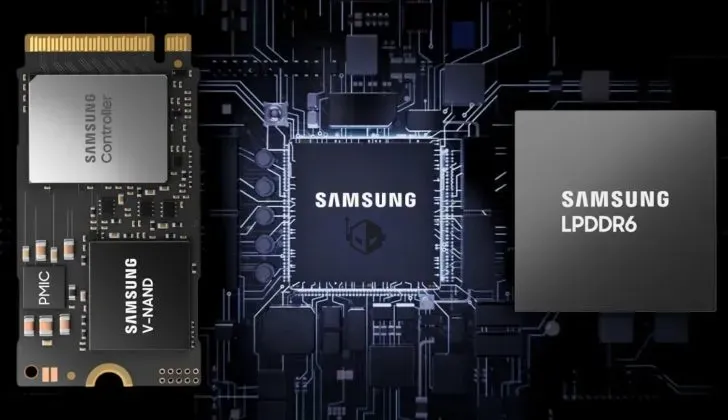LPDDR6 is the cutting-edge solution in next-generation memory technology, set to redefine mobile device memory standards. Samsung’s LPDDR6, built upon a sophisticated 12nm manufacturing process, achieves data rates of up to 10.7Gbps, making it highly suitable for AI-driven applications. Designed to accommodate the increasing demands of edge computing, this innovative memory enhances performance while maintaining energy efficiency—boasting approximately 21% more efficiency than its predecessor. Furthermore, LPDDR6 specifications include advanced safety features that protect data integrity, making it an indispensable asset in both consumer electronics and industrial applications. As we move toward a future increasingly influenced by artificial intelligence, LPDDR6 stands at the forefront, offering a reliable and efficient memory solution for next-generation devices.
The advent of LPDDR6 marks a significant leap in the evolution of mobile memory technologies. Known as low-power dynamic random-access memory for mobile applications, this new variant emerges as a vital component designed to address the accelerating requirements of modern digital experiences. With its remarkable speed and enhanced bandwidth capabilities, LPDDR6 caters to both consumer gadgets and sophisticated AI processing environments. As mobile devices become more interconnected and reliant on rapid data handling, this innovative memory type proves essential in achieving optimal performance across a myriad of applications. As we explore the future of technology, the importance of advanced memory solutions like LPDDR6 cannot be understated.
Introduction to LPDDR6
LPDDR6, the latest advancement in mobile device memory, stands at the forefront of technological innovation, addressing the increasing demand for high-performance solutions in the realms of artificial intelligence and edge computing. As the mobile ecosystem continues to evolve, the architecture and specifications of LPDDR6 have been meticulously designed to support unprecedented data rates, reaching up to 10.7Gbps. This advanced memory technology not only enhances the efficiency of mobile applications but also meets the rigorous demands of AI workloads, ensuring seamless operation even under heavy computational loads.
Samsung Electronics is a major player in this cutting-edge memory sector, consistently pushing boundaries to create products that cater to next-generation requirements. LPDDR6 represents a marked improvement in power efficiency, with a dynamic management system that provides approximately 21% greater energy savings compared to its predecessor. Such efficiency is crucial for mobile devices, particularly as they require more sustainable solutions to balance performance with energy consumption.
Why Next-Generation Memory Matters
The relevance of next-generation memory like LPDDR6 cannot be overstated, as it directly influences the performance and functionality of AI systems and mobile devices. With the ongoing integration of AI in everyday applications, the demand for higher data transfer speeds and greater bandwidth is escalating. LPDDR6, built on a cutting-edge 12nm process, caters to this need perfectly, enabling faster processing of AI tasks, enhanced multitasking capabilities, and improved overall device responsiveness.
Moreover, the specifications of LPDDR6 ensure that it meets the rigorous standards of not just consumers, but also industries reliant on advanced computing. As sectors such as automotive, healthcare, and industrial automation increasingly incorporate AI technologies, the robustness of LPDDR6 provides a reliable memory foundation that can handle large datasets and perform real-time analytics efficiently.
LPDDR6 Specifications Explained
Understanding the specifications of LPDDR6 is key to appreciating its role in modern technology. The memory’s support for data rates up to 10.7Gbps is complemented by a higher I/O count, which maximizes bandwidth and enhances data transfer speeds. This level of performance is essential for mobile devices that run complex applications, ensuring that users enjoy smooth and responsive interactions without lag.
Additionally, LPDDR6 incorporates advanced features like enhanced security mechanisms, making it a formidable choice for applications involving sensitive data. As mobile devices become increasingly integral to both personal and professional environments, the ability to safeguard information against potential threats is paramount. LPDDR6 not only meets these needs but also reinforces its position as a leading memory solution in an era where data integrity is more critical than ever.
The Future of Mobile Device Memory
As technology races forward, the future of mobile device memory is closely tied to innovations like LPDDR6. Given the rapid growth of AI and edge computing, the ability to process data quickly and efficiently will remain a key determinant in the success of mobile platforms. LPDDR6 is poised to lead this charge, setting the standard for future memory solutions that will cater to increasingly complex applications.
Furthermore, as the market for mobile device memory expands, new demands will emerge that challenge developers and manufacturers to keep up. LPDDR6’s scalable architecture and sustainable design not only meet current requirements but also future-proof technologies against the rapidly evolving landscape of mobile computing.
The Role of Samsung LPDDR6 in AI Applications
Samsung LPDDR6 plays a crucial role in supporting AI applications that are becoming more prevalent in various industries, from consumer electronics to enterprise solutions. The increased data rates offered by LPDDR6 allow for quicker data processing and analysis, which is essential for AI systems that operate on vast amounts of information. This is further backed by a robust power management system that optimizes energy use, making it ideal for devices that require prolonged performance without frequent charging.
Moreover, the adaptability of Samsung LPDDR6 ensures that it remains relevant in diverse contexts, from mobile gaming to industrial IoT applications. As AI technology continues to integrate into more sectors, having a memory solution that can handle intensive workloads while maintaining performance will be vital for success.
Enhancing Edge Computing with LPDDR6
Edge computing is a transformative trend in technology, allowing data processing to occur closer to the source of data generation, thus reducing latency and bandwidth use. LPDDR6’s high-speed capabilities significantly enhance edge computing operations, making it an invaluable resource for applications that require real-time data analysis and immediate responses. The ability to perform these tasks efficiently is crucial for industries such as manufacturing and healthcare that rely on timely data insights.
Additionally, the energy-efficient design of LPDDR6 complements edge computing frameworks well, as devices often need to operate in remote or resource-constrained environments. With its emphasis on low power consumption and high performance, LPDDR6 enables edge devices to function optimally without compromising on speed or reliability, ensuring that organizations can harness the full potential of edge computing.
Conclusion: LPDDR6 as the Memory Solution of Tomorrow
In conclusion, LPDDR6 stands out as a pivotal memory solution that meets the evolving demands of both mobile technology and AI-driven applications. Its superior specifications and innovative design provide the necessary infrastructure for high-performance computing, while its energy efficiency aligns with global sustainability goals. As industries continue to embrace digital transformation, the role of LPDDR6 in driving innovation cannot be underestimated.
As we look towards the future, LPDDR6 is not just a technological advancement; it embodies the vision of integrated, intelligent systems that will shape the next era of connectivity and computational power. By prioritizing performance, security, and sustainability, LPDDR6 will undoubtedly be at the heart of future developments in mobile device memory and beyond.
Frequently Asked Questions
What is LPDDR6 and how does it differ from previous generations of mobile device memory?
LPDDR6, or Low Power Double Data Rate 6, is a next-generation memory technology designed for mobile devices, offering significant enhancements over its predecessors. Built on a 12nm manufacturing process, LPDDR6 achieves data rates up to 10.7Gbps, which is crucial for handling data-intensive applications like AI and edge computing. Its improved I/O count also maximizes bandwidth, ensuring faster performance and better efficiency.
How does Samsung LPDDR6 improve energy efficiency for mobile applications?
Samsung LPDDR6 utilizes a dynamic power management system that intelligently adjusts power consumption based on workload demands. This innovative feature delivers around 21% better energy efficiency compared to previous LPDDR generations, making it ideal for modern mobile applications that require high performance without draining battery life.
What are the key specifications of LPDDR6 memory for AI workloads?
LPDDR6 specifications cater specifically to AI workloads by offering high data rates of up to 10.7Gbps and advanced power management capabilities. These features allow for efficient processing of large datasets while maintaining a low energy footprint, making LPDDR6 a suitable choice for AI-driven mobile devices.
Why is LPDDR6 considered a critical memory solution for future mobile devices?
LPDDR6 is critical for future mobile devices due to its ability to support high-speed data transfer, enhanced energy efficiency, and robust security features. As mobile platforms evolve with AI and edge computing, LPDDR6’s scalable architecture will enable devices to perform complex tasks seamlessly while ensuring data integrity.
How does LPDDR6 contribute to enhanced security in mobile and industrial applications?
LPDDR6 introduces improved security mechanisms that protect data integrity, making it suitable for both mobile devices and industrial applications. Its advanced features are designed to support mission-critical environments where reliability and security are paramount, thus expanding the use of LPDDR6 beyond traditional consumer applications.
What applications are best suited for LPDDR6 memory in the context of next-generation technology?
LPDDR6 memory is best suited for applications that require high performance and efficiency, such as AI-driven mobile applications, edge computing devices, and other data-intensive environments. Its ability to handle large workloads and maintain energy efficiency makes it ideal for the advancing technological landscape.
| Key Features | Details |
|---|---|
| Advanced Process Technology | Built on a 12nm process for enhanced performance and efficiency |
| Data Rates | Supports data rates up to 10.7Gbps, ideal for high-bandwidth applications |
| Power Efficiency | Offers approximately 21% better energy efficiency than previous generations |
| Security Features | Enhanced security mechanisms for maintaining data integrity |
| Applications | Perfect for mobile, edge computing, and AI workloads |
| Eco-conscious Design | Designed to balance performance and environmental responsibility |
Summary
LPDDR6 represents a pivotal advancement in memory technology, catering to the growing needs of mobile devices, AI, and edge computing. With its remarkable data rates, energy efficiency, and robust security features, LPDDR6 is poised to play a crucial role in shaping the future of intelligent systems and applications.








